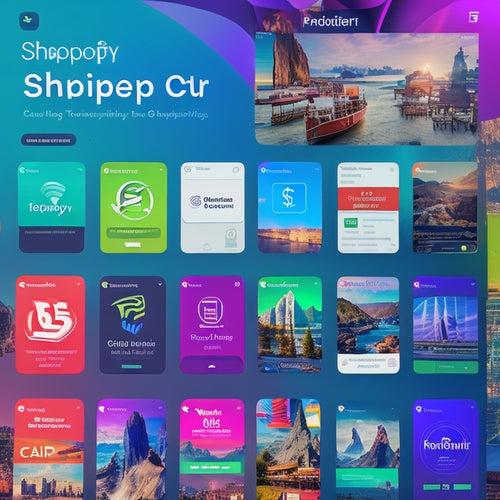Increase Engagement With User-generated Content
Share
In today's digital landscape, businesses are constantly seeking innovative ways to engage their audience and drive sales. One promising approach is the utilization of user-generated content (UGC) and shoppable videos.
This article explores the power of UGC in marketing and highlights the rise of shoppable videos as a means to enhance customer engagement. By examining successful UGC and shoppable video campaigns, we will uncover the benefits of incorporating these strategies into your marketing efforts.
Discover how harnessing UGC can foster a sense of belonging among your target audience while driving conversions.
- User-generated content (UGC) and shoppable videos can increase brand awareness and generate excitement and buzz.
- UGC and shoppable videos foster a sense of community and enhance user engagement.
- Incentivizing content creation and encouraging participation can help to boost UGC.
- Incorporating UGC and shoppable videos in marketing efforts can increase user engagement, enhance brand visibility, and improve overall marketing ROI.
Harnessing the Power of User-Generated Content (UGC)
The utilization of user-generated content (UGC) has been acknowledged as an effective strategy for increasing engagement with consumers through shoppable videos. UGC marketing strategies involve incorporating content created by users, such as reviews, testimonials, and social media posts, into brand campaigns. By harnessing the power of UGC, businesses can tap into the authenticity and trust that comes from peer-to-peer recommendations.
One key advantage of using UGC in shoppable videos is its potential to create a sense of belonging among consumers. When individuals see content created by their peers, they are more likely to feel connected to the brand and its products. This sense of connection drives engagement and encourages viewers to take action.
Furthermore, UGC provides valuable insights for brands through measurement and analytics. By tracking metrics such as likes, comments, shares, and conversions associated with UGC campaigns, businesses can gain a deep understanding of consumer preferences and behaviors. This data-driven approach allows companies to refine their marketing strategies and optimize their shoppable video experiences accordingly.
In conclusion, incorporating user-generated content in shoppable videos is a powerful way to increase engagement with consumers. By leveraging the authenticity and peer-to-peer influence that comes from UGC marketing strategies, businesses can foster a sense of belonging among customers while gaining valuable insights through measurement and analytics.
The Rise of Shoppable Videos
One notable trend in digital marketing involves the integration of e-commerce functionality within video content. This trend, known as shoppable videos, has gained traction in recent years due to its ability to increase engagement and drive sales.
Shoppable videos allow viewers to interact with the content by clicking on specific items within the video that they are interested in purchasing. This interactive shopping experience not only enhances user engagement but also provides a seamless transition from discovery to purchase.
Moreover, shoppable videos have found success through social media integration. With the rise of platforms like Instagram and TikTok, brands have leveraged these channels to showcase their products through captivating video content. By incorporating e-commerce functionality into these videos, brands can directly link viewers to product pages or add items directly to their shopping carts without leaving the platform.
The appeal of shoppable videos lies in their ability to create a sense of belonging for consumers. By allowing viewers to shop while watching engaging video content, brands are able to provide an immersive and personalized experience that fosters a connection between the consumer and the brand.
In conclusion, shoppable videos offer an innovative approach for increasing engagement with user-generated content while providing interactive shopping experiences for consumers. Their integration with social media platforms further amplifies their reach and impact, making them a valuable tool for brands looking to enhance their digital marketing strategies.
Benefits of Utilizing UGC in Marketing
Utilizing user-generated content (UGC) in marketing offers several benefits.
Firstly, it is a cost-effective strategy that can yield a high return on investment (ROI). By leveraging UGC, companies can reduce their expenses on creating original content while still engaging with their audience effectively.
Secondly, incorporating UGC increases engagement and brand awareness. User-generated content tends to resonate more with consumers as it is authentic and relatable, leading to higher levels of interaction and brand recognition.
Lastly, by involving users in the creative process, companies can tap into their creativity to generate fresh and innovative content ideas that align with their target audience's preferences and interests. This approach not only adds variety to marketing campaigns but also enhances the overall user experience.
Cost-Effectiveness and ROI
To assess the cost-effectiveness and ROI of incorporating user-generated content (UGC) in shoppable videos, various metrics can be employed. Measuring effectiveness is crucial for determining the success of UGC campaigns.
Brands can track conversions by monitoring click-through rates, sales generated from UGC, or engagement metrics such as likes, comments, and shares. This data allows marketers to evaluate the impact of UGC on their overall marketing strategy.
Furthermore, brands can calculate the return on investment (ROI) by comparing the cost of creating and promoting UGC with the revenue generated from it. By analyzing these metrics, businesses can determine whether their investment in user-generated content is yielding favorable results and adjust their strategies accordingly.
Incorporating UGC in shoppable videos has proven to be a cost-effective approach that drives engagement and boosts sales for brands.
Increased Engagement and Brand Awareness
Enhanced consumer interaction and improved visibility of the brand are outcomes that can be observed with the incorporation of user-generated content in shoppable video campaigns.
User-generated content (UGC) has become a powerful marketing tool, allowing brands to engage with their audience on a deeper level. By encouraging consumers to create and share content related to the brand, companies can tap into their customers' creativity and passion for the products or services offered.
This not only increases engagement but also enhances brand awareness as UGC often reaches a wider audience through social media platforms. Furthermore, UGC adds authenticity and credibility to the brand, as it is created by real customers rather than being solely company-produced.
Overall, incorporating user-generated content in shoppable videos can significantly boost engagement levels and increase brand awareness among consumers.
Leveraging User Creativity for Fresh Content
Leveraging the creativity of consumers allows brands to continually produce fresh and innovative content. By encouraging participation from their audience, brands can tap into a virtually limitless source of ideas and perspectives. This not only fosters brand loyalty but also creates a sense of belonging for consumers who feel valued and heard.
To fully grasp the benefits of user-generated content (UGC), consider the following:
-
Authenticity: UGC adds authenticity to a brand's marketing efforts, as it is created by real people with genuine experiences.
-
Diverse Perspectives: User creativity brings in diverse perspectives that resonate with different segments of the audience.
-
Cost-effective Solution: Leveraging consumer creativity reduces production costs while maintaining high-quality content.
-
Social Proof: Encouraging users to share their creations builds social proof, as potential customers trust recommendations from peers more than traditional advertising.
By leveraging user creativity, brands can tap into an endless wellspring of fresh ideas while fostering loyalty among their customers.
Strategies for Encouraging UGC
Encouraging user-generated content can be achieved through the implementation of various strategies. One effective approach is to encourage participation by creating a sense of community and belonging among users. By fostering a supportive environment where individuals feel valued and heard, they are more likely to engage in content creation. This can be accomplished through interactive features such as comment sections, forums, or social media groups dedicated to sharing user-generated content.
In addition to promoting participation, incentivizing creation can also be an effective strategy. Providing rewards or recognition for users who contribute high-quality content can serve as motivation for others to get involved. This could include features such as badges or rankings based on the number or quality of contributions.
Furthermore, brands can consider running contests or campaigns that invite users to submit their own content for a chance to win prizes or have their work featured. This not only encourages engagement but also creates excitement and buzz around the brand.
Overall, by implementing strategies that focus on encouraging participation and incentivizing creation, companies can successfully increase user-generated content. These approaches foster a sense of belonging within the community while simultaneously providing individuals with motivation and rewards for their efforts.
Case Studies: Successful UGC and Shoppable Video Campaigns
In the previous subtopic, we explored various strategies for encouraging user-generated content (UGC). Now, let us delve into the realm of successful UGC and shoppable video campaigns through case studies. These real-life examples provide valuable insights into the effective implementation of UGC strategies and how they can be enhanced by incorporating shoppable videos.
One noteworthy case study is the campaign launched by a popular beauty brand. They encouraged their followers to share videos showcasing their makeup skills using the brand's products. By offering incentives such as featuring the best videos on their official website and social media channels, they successfully motivated users to create engaging content. This not only increased brand awareness but also fostered a sense of community among their loyal customers.
Another remarkable example is an online clothing retailer that implemented shoppable video campaigns effectively. By integrating clickable product links directly within their videos, customers were able to make purchases seamlessly while watching captivating content. This innovative approach significantly improved user engagement and boosted conversion rates.
These successful UGC strategies combined with shoppable video campaigns demonstrate how brands can harness the power of user-generated content to drive sales and increase customer loyalty. By incorporating these tactics into their marketing efforts, businesses can establish a strong connection with their audience while providing them with an interactive and seamless shopping experience.
Frequently Asked Questions
How can businesses effectively incentivize customers to create user-generated content?
Effective incentives for user-generated content include rewards and discounts. Businesses can also use gamification techniques to encourage customers to create content. These strategies can increase customer engagement and foster a sense of belonging within the community.
What are some best practices for incorporating shoppable videos into a marketing campaign?
Incorporating user-generated content and shoppable videos in a marketing campaign can be enhanced through effective incentives. Best practices include providing clear instructions, showcasing authentic content, enabling easy purchasing options, and fostering a sense of community and belonging.
Are there any potential downsides or risks associated with utilizing user-generated content in marketing?
Potential challenges and legal considerations associated with utilizing user-generated content in marketing include copyright infringement, privacy concerns, and the risk of negative or inappropriate content. Careful moderation, clear guidelines, and obtaining proper permissions can help mitigate these risks.
How can businesses measure the success and impact of their user-generated content and shoppable video campaigns?
The success and impact of user-generated content and shoppable video campaigns can be measured by analyzing data such as engagement metrics, conversion rates, and sales figures. This allows businesses to objectively assess the effectiveness of their marketing strategies.
What are some examples of industries or businesses that have successfully implemented user-generated content and shoppable videos in their marketing strategies?
Successful user-generated content and shoppable video examples can be found in the fashion industry and beauty brands. These industries have effectively incorporated user-generated content and shoppable videos into their marketing strategies, resulting in increased engagement and sales.
Related Posts
-
The Power Of Shoppable Videos: Revolutionizing Ecommerce
Shoppable videos have emerged as a game-changer in the ecommerce industry, reshaping the way customers interact with ...
-

What Are the Benefits of Using Shopify for E Commerce
This article examines the benefits of implementing Shopify for e-commerce businesses. By utilizing an academic style...
-

Unlocking Revenue Potential: Join the Shopify App Store Revenue Share Plan
The Shopify App Store has implemented a new revenue share plan for its partners, aimed at unlocking their revenue po...

